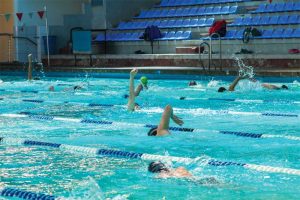
by Julie Holmquist
In 1971, Israel began using its first Olympic-sized swimming pool; the Wingate pool played a significant role in Israeli athletics as swimmers spent countless hours splashing through its water for daily practice. Athletes came from around the world to participate in international competitions held there.
In 2013, a new Olympic pool was built to take its place as the primary venue for competitions, while the first pool continued to be used for practice. Half a century of exposure to a naturally corrosive environment took its toll on the concrete elements, causing leaks and concrete delamination requiring repeated repairs. Not until 2016, when the pool was diagnosed with active rebar corrosion in its walls, was anything more than local repairs considered.
In hindsight, one wonders if proactive corrosion mitigation could have led to fewer repairs in the first place. Whatever the case, the story underscores the importance of understanding heightened corrosion risk factors for certain concrete water handling structures—from swimming pools to seawalls to desalination plants—and not overlooking longevity in the face of a short-term fix.
Many possible design strategies exist to maximize the service life of a concrete structure, delay corrosion, and minimize repair time. While these should be fairly considered, one of the most practical and economical technologies for construction specifiers, engineers, and building owners to be aware of is migrating corrosion inhibitors (MCIs) as this technology can be particularly helpful when it comes to corrosive water handling environments.

Corrosive concrete water handling environments
Pools are a highly corrosive environment requiring special corrosion mitigation considerations for a few reasons; one is convection in the indoor pool environment that can deposit wet films with dissolved salts on surfaces in the facility. Another is hypochlorous acid (HOCl)—a strong oxidizer that forms in pools as a byproduct of adding chlorine gas to the water for disinfection. Combined with high humidity, these elements create an extremely harsh environment and accelerate corrosion. Maintenance corridors and cellars around and under pools are as harsh as the facilities above the water, facilitating a corrosive environment on both sides of the concrete.
Seawalls are also exposed to extreme conditions. Built along shorelines to resist erosion, seawalls are in direct contact with saltwater, which, when absorbed, can be a harsh electrolyte to accelerate the corrosion of embedded steel reinforcement. A humid environment with high temperatures will cause the corrosion rate to accelerate even more. The seawall owner can expect repairs at an early age, unless special precautions are taken.
Even more extreme are conditions encountered by concrete elements in a desalination plant. Hadar Halperin, a construction consultant familiar with the heightened corrosion risks of desalination and other harsh environments in the Middle East, explained that the salinity level of the Mediterranean Sea near Israel is around 3.8 percent. Designers of two large desalination plants in Israel had to compensate for this high salinity level when constructing jack-pipes to feed seawater into the plant and discharge brine back to the sea.
During the desalination process, the seawater doubles in salinity to around seven percent in the resulting brine wastewater, Halperin explained. Those dealing with desalination water in the Red Sea region have to battle even higher baseline salinity of about 4.1 percent. Reinforced concrete used in brine water holding tanks or disposal channels at desalination plants therefore likely face double the threat of corrosion experienced by a seawall.




